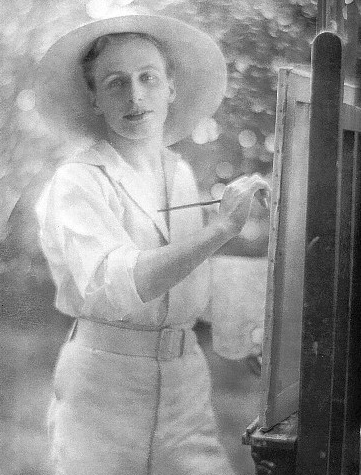Born in 1881, William Bruce Ellis Ranken was a Scottish artist and Edwardian Aesthete. He had an idyllic childhood living in vast estates in Scotland and England. He attended Eton College and then on to the Slade School of Art, under the tutelage of Henry Tonks. This is where he met his fellow student, the actor Ernest Thesiger who became a lifelong friend.

At the age of 23, Ranken had his first exhibition at London’s Carfax Gallery and in 1907 he moved to Chelsea where he first began socialising with the Edwardian Aesthetes and the country’s artistic elite.
It was around this time that he met and befriended the artist John Singer Sargent, who became his mentor, as well as becoming close friends with the photographer Baron De Meyer.
“Mr Ranken is one of the few painters of the present day who shows in his work a genuine love of the gorgeous, the stately and the splendid”
- Joseph Duveen, art critique

Ranken's love of the high-life treated him well. Many of his friends and patrons were also queer artists. The Advocate's list of those friends included composer Cole Porter, writer Violet Keppel Trefusis, Anne Morgan, and her lover Elsie de Wolfe, the literary agent Elizabeth Marbury who was also de Wolfe’s lover, the famous collector Henry Davis Sleeper and his life long lover, actor Ernest Thesiger, William Lygon, Earl Beauchamp, and his middle son, the Honorable Hugh Lygon, who was one of the inspirations for Sebastian Flyte.
He enjoyed bohemian life and beauty, making portraits of many beautiful aristocrats, radiant men and women, such as Queen Elizabeth, and Olga Alberta, Baroness de Meyer, who he painted in Venice, which can still be seen at the Leeds Museum and Galleries.

Ranken purchased Warbrook House, Eversley, Hampshire, in 1918 after the success of his first visit to America, (he was unable to serve in the war due to consequences of contracting polio as a child), where he collected and repaired historical pieces of embroidery for sale with Ernest Thesiger. His other hobbies included music, antiques, interior decoration and gardening.

The maintenance and costs associated with Warbrook House proved to be too much in the depression of the early 1930s, and he was forced to give up his beloved house.
Tragically, Ranken died of a cerebral haemorrhage in 1941. His final major work, was his painting of the coronation of King George VI in 1937 at Westminster Abbey.
His sister Janette donated over 200 works to be distributed amongst UK public galleries and museums, though many were destroyed in the blitz.
Below is one of my favourites.

I came across Mr Ranken as I was searching for queer British artists and in all the pictures of grim looking men painted or photographed in bleak lighting and drab clothes. I finally came across a picture of him with a sweet expression on his bright face peering out of a wide brimmed sun hat and wearing a similar outfit as his model in his painting, the young polo player (directly above), and I was delighted to find all of his paintings were equally beautiful. There are very few painters that have created such a vast amount of work that I would proudly cover every wall in my house with. Mr Ranken is certainly one of them.
Reading Recommendations & Content Considerations
There are no books that I can find about William Bruce Ellis Ranken but I guess that's what it is to be a 'lost artist '. Below are links to where you can see more of his work, when they were painted and where the original paintings are currently hanging. Most are housed in museums around Britain and are easily accessible thanks to his sister Janette.





















































留言